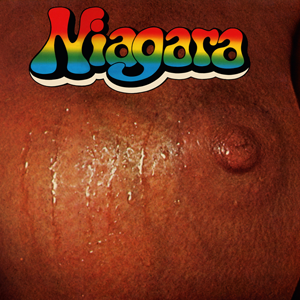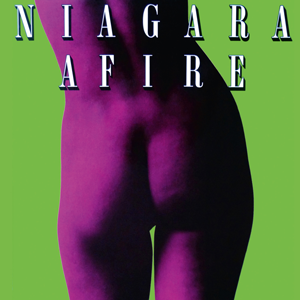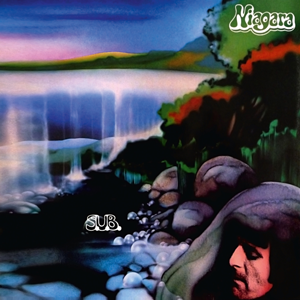
Niagara – ”Niagara/S.U.B./Afire”
The first NIAGARA album – simply called “Niagara” – was released in 1971 and was noticed even by those unfamiliar with Niagrara’s music due to the controversal “sweaty breasts” album cover. The album was unusual not only because of its cover. It was a purely percussive album on which numerous high-profile drummers from around the world came together; Americans Cotch Blackmon and George Green, Englishman Keith Forsey, Juan Romero from Venezuela and the German musicians Udo Lindenberg and Daniel Fichelscher (who also played in Gila, Amon Düül II and Popol Vuh).
“Niagara” remains a unique, driving mix of jazz, rock and skilful adaptations of African elements, captured in two long epic tracks.
The encouraging success of the debut album lead to the follow-up, “S.U.B: ” in 1972.
The percussion concept had been revisited and even expanded upon, not the least of which was the impressive instrumentation. The result was no longer as homogeneous as its predecessor, but rather a colorful fireworks display, greatly influenced by bassist Gary Unwin.
Returning to the original concept, Niagara recorded a third and final album, “Afire” (1973), again the brainchild of Klaus Weiss.
Niagara – Niagara
Born on February 17, 1942 in Gevelsberg, during the late ‘50s and’60s, Klaus Weiss was one of the few experienced jazz drummers admired by his American counterparts .
Sepp Werkmeister , Klaus Weiss’s long-time companion, remembers Klaus “being the only European drummer with American Feeling”, making him much sought after for session work by his American colleagues. In addition, his experience, competence and his inimitable playing brought him, not only to lead a number of big band projects, but also to perform with the likes of Cecil Bridgewater, Johnny Griffin and Herbie Mann on stage.
But Weiss was not a purist. Although he did have a defined style, he also explored many other genres, including new world and rock.
Or, as Sepp Werkmeister puts it: “For Klaus, a drummer always has a key position musically. Perhaps more than any other musician, he understood a percussionist’s musical responsibility, whether drumming in a big band or in a trio. Although a jazz musician at heart, Klaus also worked very extensively with world music. Rock was not really his thing, but when Miles Davis recorded this kind of music himself, he was encouraged by Miles to foray his way into Rock as well.”
Back in the 60s, Weiss played with the German jazz saxophonist Klaus Doldinger in his quintet, and then years later, again with Doldinger, with a relatively unknown drummer who was on the first NIAGARA project. That drummer was Udo Lindenberg.
The first NIAGARA album – simply called “Niagara” – was released in 1971 and was noticed even by those unfamiliar with Niagrara’s music due to the controversal “sweaty breasts” album cover.
The album was unusual not only because of its cover. It was a purely percussive album on which numerous high-profile drummers from around the world came together; Americans Cotch Blackmon and George Green, Englishman Keith Forsey, Juan Romero from Venezuela and the German musicians Udo Lindenberg and Daniel Fichelscher (who also played in Gila, Amon Düül II and Popol Vuh).
“Niagara” remains a unique, driving mix of jazz, rock and skilful adaptations of African elements, captured in two long epic tracks.
Despite the improvised nature, “Niagara” was very stringent.
Sepp Werkmeister: “Klaus’ precision was striking. Until recently, he never played on plastic skins, only on natural fur which today would be considered a novelty. Playing on these natural skins is something that very few musicians ever master.“
The encouraging success of the debut album lead to the follow-up, “S.U.B:” in 1972.
The percussion concept had been revisited and even expanded upon, not the least of which was the impressive instrumentation. Only Udo Lindenberg and Daniel Fichelscher were left of the original recording lineup. Added were Gary Unwin (bass), Christian Schulze (piano), Ack van Rooyen (flugelhorn, trumpet), Paul Vincent (guitar), Ferdinand Povel (sax, flute) and Joe Harris (percussion).
The result was no longer as homogeneous as its predecessor, but rather a colorful fireworks display, greatly influenced by bassist Gary Unwin. Unwin is also responsible as the composer of two of the tracks, one of which, “Gibli”, reflects the repetitive, psychedelic character of that time.
Returning to the original concept, Niagara recorded a third and final album, “Afire” (1973), again the brainchild of Klaus Weiss. On “Afire”, Klaus did not include Lindenberg and Fichelscher for this recording, but he did invite bassist Dave King (member of Embryo and Toto Blanke) and the percussionists George Brown, Sabu Rex and Norman Tolbert.
The three NIAGARA albums had not been available for many years, until they were completely remastered in 2010 by Eroc (Grobschnitt) and underlining once again, the originality and timelessness of this music.
In spite of its drive and lively character, NIAGARA remained basically a studio project which was greatly enhanced by Klaus Weiss’s extraordinary production skills.
Klaus Weiss died unexpected on December 10, 2008 in Pfaffenhofen an der Ilm.
Tracklisting:
CD 1: Niagara / S.U.B.
1. Sangandongo 19:07
2. Malanga 20:42
3. S.U.B. 11:56
4. Bones 03:12
5. Niagara 04:30
CD 1 complete: 59:27
CD 2: Afire / S.U.B.
1. What For 02:30
2. City Walk 04:32
3. Terpsichore 06:16
4. Rhythm Go 02:44
5. Carnival 02:34
6. Malanga Two 02:42
7. Rolling 05:23
8. Dane In Seven 03:44
9. Bangu 01:40
10. The Third One 03:24
11. Afire 05:23
12. Katarrh 05:54
13. Kikiriti 04:55
14. Gibli 05:28
15. Terra Incognita 04:06
CD 2 complete: 61:35


